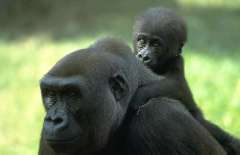Overview
 Order: Primates
Order: Primates
Family: Hominidae
IUCN Red List Status: Critically Endangered
Population Trend: decreasing
Mountain gorilla: (Gorilla gorilla beringei)
Eastern lowland gorilla: (Gorilla gorilla graueri)
Western lowland gorilla: (Gorilla gorilla gorilla)
Distribution:
Mountain gorilla - the Virunga volcanoes region in eastern Zaire, Rwanda and Uganda.
Eastern lowland gorilla - eastern Zaire.
Western lowland gorilla - West Africa and Congo basin.
Habitat: Mountain gorilla - rainforest between 9,000 and 12,000 ft. above sea-level. Lowland gorillas - rainforest up to about 8,000 ft.
Sizes: Height; male 1.8m (standing upright); female 1.5m. Weight; male 140 - 275kg; female 70 - 140kg
Life-span: About 30 years in the wild.
Description: Mountain gorillas have shorter arms and longer, silkier hair than lowland gorillas. Eastern gorillas have blacker hair than western, with bigger jaws and teeth. Only western lowland and mountain males develop silvery-white backs when mature. Jet-black skin, small ears, broad chest. Powerful arms, longer than the legs. Males have a larger, domed head than females.
Territory: Gorillas live in family groups of 10 to 30, consisting of a single adult male and several females with their young. Other males usually wander alone, sometimes joining a group for a while. The home ranges of groups overlap and there is no defended territory; groups of gorillas which live within the same area get on with each other peacefully, sometimes mingling for a while or simply ignoring one another.
Read More: Daily Life